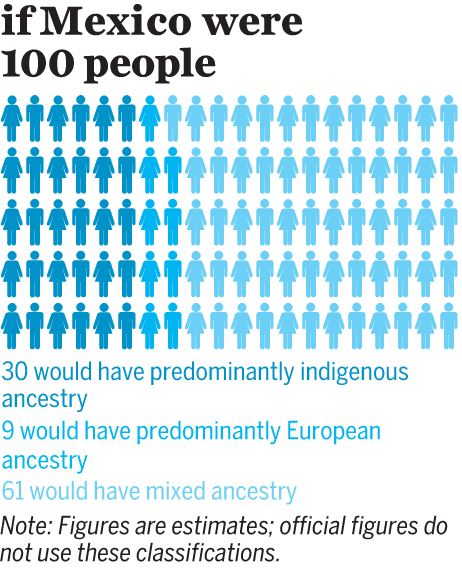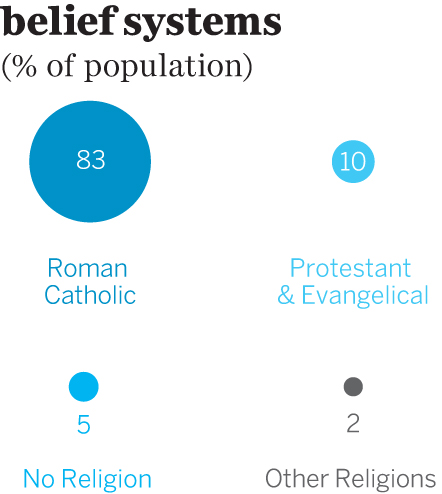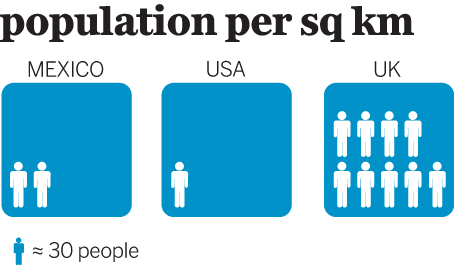Mexico Today
As President Enrique Peña Nieto, of Mexico’s longtime ruling party Partido Revolucionario Institucional (PRI), approaches the end of his six-year term in 2018, a number of problems remain unsolved. While his economic reforms have given the economy a boost, crime has been on the rise, and government investigations into the 2014 case of the 43 murdered students have been discredited, with the case still unsolved. On top of that, Mexico’s relations with its neighbor to the north have rarely been frostier.
Best on Film
Amores Perros (Love’s a Bitch; 2000) Gritty groundbreaker that set director Alejandro González Iñárritu and actor Gael García Bernal on the path to stardom.
Y Tu Mamá También (And Your Mother Too; 2001) Classic coming-of-age road trip movie about two privileged Mexico City teenagers.
Heli (2013) Amat Escalante won Cannes’ best-director garland for this tale of a young couple caught up in the drugs war.
600 Miles (2015) Tim Roth plays a kidnapped US law-enforcement agent in Gabriel Ripstein’s thriller.
Best in Print
Pedro Páramo (Juan Rulfo; 1955) Compelling tale of a hallucinatory ghost town; considered the world’s first published work of magical realism.
El Narco (Ioan Grillo; 2011) An exposé on Mexico’s drugs war, researched in dangerous territories.
Quesadillas (Juan Pablo Villalobos; 2013) Hard-hitting, almost surreal satire on poverty and corruption in a small Jalisco town in the 1980s.
God’s Middle Finger (Richard Grant; 2008) Perilous journey into the narco-riddled Sierra Madre Occidental.
Sliced Iguana (Isabella Tree; 2008) Warm, perceptive account of Mexico and its indigenous cultures.
Crime & the 43
Mexico has been struggling with over three decades of increasingly violent activity involving drug gangs, who have corrupted many government officials, politicians and members of the security forces along the way. President Peña Nieto came to power with the stated intention of trying to tackle the root causes of cartel violence at a local level. But according to Mexico’s Citizens’ Council for Public Security, organized-crime-related killings were happening at a rate of about 23,000 per year in late 2016. The government scored a much-needed triumph when Mexico’s most wanted man, Joaquín ‘El Chapo’ Guzmán, leader of the powerful Sinaloa cartel, was captured in 2014 – and suffered a desperate disaster when he escaped the following year. The government regained some credibility when he was recaptured in early 2016.
The drug gangs don’t just ship drugs to the USA. They traffic people too, and kidnap people for ransom, and practice extortion. Mexico has one of the world’s highest kidnapping rates, estimated by the country’s Human Rights Commission at a staggering 274 per day. The common perception that the authorities are often in league with the cartels is what unleashed the wave of disgust after the Iguala incident.
On September 26, 2014, three trainee teachers from Ayotzinapa in Guerrero state were killed by municipal police in the city of Iguala, and another 43 students disappeared. The event sparked months of protests around the country in an outpouring of Mexicans’ anger and grief about the insecurity of their country and the perceived corruption, criminality and impunity of so many in authority. It has now been officially established that the 43 were kidnapped by police, though the government’s version that the students were then handed over to cartel members who massacred them after mistaking them for a rival gang has been discredited.
Independent investigations conducted by the Inter-American Commission on Human Rights and a group of Argentine forensic experts, in conjunction with a data platform provided by the British research group Forensic Architecture, have established that the attacks that night involved highly coordinated local and federal police forces. The level of government involvement is yet to be determined. With the remains of only two students identified to date, the families of the disappeared continue to seek answers.
The Economy
Mexico’s crime problem and international relations aside, the economy has been growing at a fairly steady rate of around 2.5% per year ever since Peña Nieto’s technocrat government embraced market- and investor-friendly reforms in order to boost both production and competition. Opening the oil industry to private investment and competition was a bold move, since the hugely inefficient Pemex, or Petroleos Mexicanos, was state-owned and responsible for around a fifth of the government’s budget. The reform paid off, increasing foreign investment and making Mexico’s economy less vulnerable to fluctuating oil prices. Laws passed in 2014 finally allowed more competition into telecoms, and other Peña Nieto reforms have involved overhauling the financial system in order to lower borrowing costs and to strengthen competition. However, a growing economy alone has been insufficient in tackling Mexico’s endemic corruption problem or the vast wealth inequality, and the wealthiest 10% of the population still earns around 30 times as much as the poorest 10%.
While organized crime has been encroaching on previously untouched parts of Mexico, particularly those popular with tourists, the latter don’t seem to be put off. International tourist arrivals in Mexico reached a record 29.3 million in 2014, and the numbers in 2015 and 2016 eclipsed that record.
US-Mexico Relations
There is a stark contrast between the warm relations between President Peña Nieto and former US president Barack Obama, and Nieto’s relationship with Donald Trump. During Obama’s presidency, Mexico was lauded as one of the USA’s closest trading partners, with the two governments working together to promote clean energy and protect the environment, with bolstered security cooperation regarding the US–Mexico border. With the advent of Trump, much has changed. During the campaign trail and into his presidency, Trump repeatedly cast aspersions on the character of Mexican immigrants. While the Trump-promised wall between the US and Mexico was nowhere near being constructed during research time, Trump’s repeated claims that Mexico would pay for the wall was ridiculed both in the Mexican press and by former president Vicente Fox in a viral video recording. Claiming that Mexico is a threat to the US economy, Trump has also threatened to pull the US out of the NAFTA agreement, which is an additional headache for Mexico’s government.
POPULATION:
127.5 MILLION
AREA:
1,972,550 SQ KM
GDP PER CAPITA:
US$9707
POPULATION BELOW POVERTY LINE:
47%
RECOGNIZED NATIONAL LANGUAGES:
69


